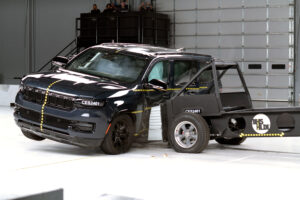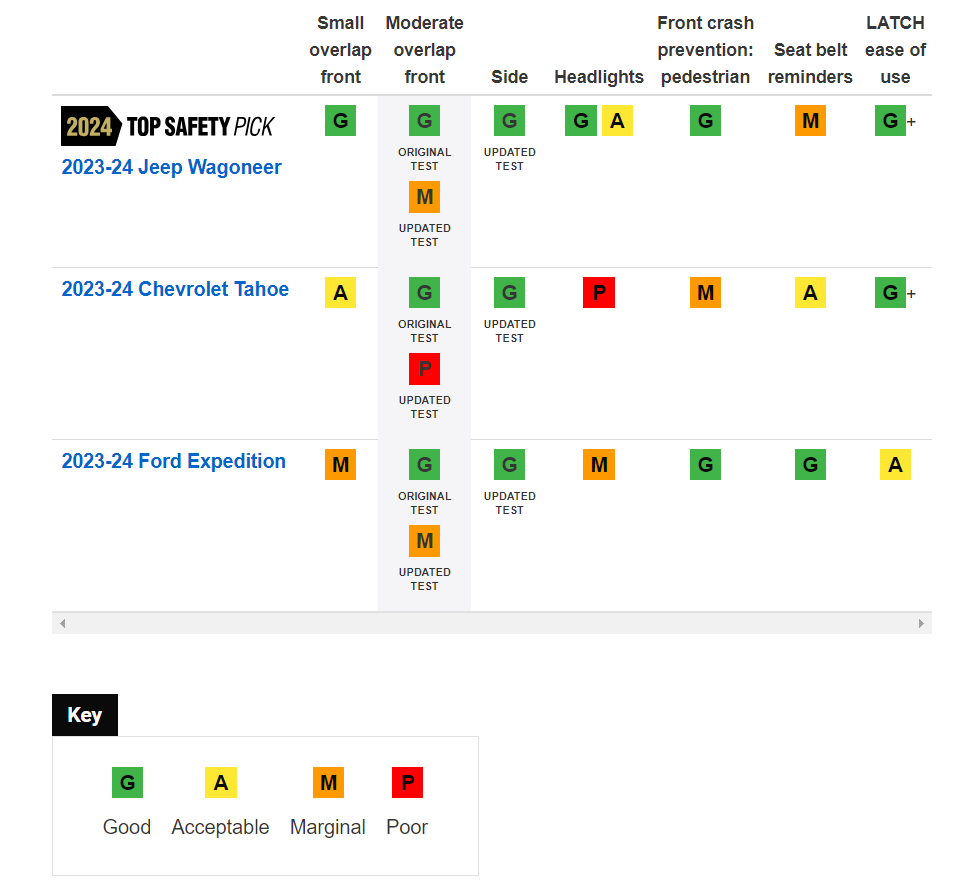
Wagoneer excels, Tahoe and Expedition underperform in first IIHS crash tests
By onAnnouncements | Technology
The Jeep Wagoneer is the only model out of three popular large SUVs tested by the Insurance Institute for Highway Safety (IIHS) to qualify for a 2024 Top Safety Pick award while others “fell short with subpar performance” in the small overlap front crash test.
Those included bestsellers Chevrolet Tahoe and Ford Expedition. More than 90% of new models have sailed through this evaluation with good ratings since 2021, according to IIHS. The large class of SUVs hadn’t previously been tested by IIHS, according to Raul Arbelaez, IIHS Vehicle Research Center vice president. All of the ratings apply to model years 2023 and 2024.
“These vehicles are designed to be people haulers, as well as to tow boats and campers but none of them offer good protection for back seat passengers — a shortcoming that prevents the Wagoneer from earning the higher-tier Top Safety Pick+ award,” IIHS said in a news release.
In the small overlap evaluation, based on tests conducted on both sides of the vehicle, the good-rated Wagoneer performed well at maintaining survival space for the driver and front passenger but slightly worse in the driver-side test. During that test, there was slight intrusion in the footwell resulting in a modest risk of injury to the driver’s left foot and ankle, IIHS said.
In both the driver- and passenger-side tests, the front and side curtain air bags worked correctly to prevent the crash dummy heads from coming close to the stiff structures of the vehicle, and measures taken from the dummies did not show any other heightened risk.
“The huge mass of these large SUVs provides some additional protection in crashes with smaller vehicles, though that also means they present more danger to other road users,” said IIHS President David Harkey, in the release. “The flip side of their large size is that there is a lot more force to manage when they crash into a fixed obstacle like a tree or bridge abutment or the barrier we use in our front crash tests.”
Those high forces proved to be challenging for all three vehicles, but the Wagoneer outperformed the others.
In the driver-side test, the acceptable-rated Tahoe maintained adequate survival space for the driver, and the air bags and restraints worked well; however, there was enough intrusion into the footwell that injury measures taken from the driver dummy showed a substantial risk of lower leg injuries, IIHS found.
Performance was worse in the passenger-side test. Extensive intrusion into the footwell contributed to a high risk of injury to the right foot and moderate risk of injury to the left leg of the passenger.
The structure of the marginal-rated Expedition didn’t hold up in the tests of either side. In the driver-side test, the steering column partially detached from the instrument panel, and in both tests, the A-pillar separated from the rocker panel. Excessive intrusion into the footwell contributed to a high risk of injury to the driver’s right leg and moderate risk to the left. Footwell intrusion was also seen in the passenger-side test to a lesser extent.
All three vehicles earned a good rating in the original moderate overlap front evaluation, which only considers the level of protection provided in the front seat. None allowed substantial intrusion into the driver’s survival space. However, the driver dummy’s head hit the steering wheel through the air bag in the Wagoneer, and the driver’s side curtain air bag in the Expedition didn’t deploy during the test, IIHS said.
For these vehicles, the test was run with an additional dummy in the second row so that updated moderate overlap ratings could be calculated.
Factoring in restraint performance and injury risk for a second-row passenger, none of the vehicles performed well.
In all three, measurements taken from the rear dummy showed a fairly high risk of chest injuries because of high seat belt forces. The air bags and restraints in the marginal-rated Wagoneer functioned well otherwise.
Only the marginal-rated Expedition has second-row belt pretensioners, which can mitigate belt forces, but its injury metrics were no better than those seen in the other two SUVs, IIHS said. The Expedition’s side curtain air bag for the rear passenger also failed to deploy, but that wasn’t enough to change its overall rating.
In the poor-rated Tahoe, measurements taken from the rear dummy showed a high risk of head or neck injuries, along with chest injury risks. The second-row lap belt in the Tahoe also slid onto the rear dummy’s abdomen from the ideal position on the pelvis, increasing the risk of abdominal injuries.
“These discouraging results show that some popular vehicles still lag behind in meeting the most advanced safety standards,” Arbelaez said, in the release. “The good news is that the top performer in this class proves that automakers can readily address these problems.”
All three SUVs received good ratings in the updated side test, though the rear dummy’s head thumped hard against the side curtain air bag in the Expedition.
In the pedestrian crash avoidance evaluation, the standard front crash prevention systems in the Expedition and Wagoneer earned good ratings. Both vehicles avoided collisions with the pedestrian dummy in most daytime and nighttime test scenarios.
All trims of the Wagoneer also come with acceptable- or good-rated headlights. The headlights supplied on all trims of the Expedition earned a marginal rating because they struggle to illuminate the road well enough on curves, and the low beams produce too much glare for oncoming drivers, according to IIHS.
The Tahoe earned a marginal rating in the pedestrian test. Its standard system avoided hitting the pedestrian dummy or slowed substantially to mitigate the force of impact in all the daylight tests, but it faltered in the dark, IIHS said. In the 12 mph scenario that simulates an adult walking across the roadway in front of the vehicle at night, the Tahoe reduced its speed by only 3 mph when using its high beams and didn’t slow at all when using its low beams. It also slowed by only 2 mph when using its low beams in the 25 mph crossing adult test.
IIHS concluded that the poor-rated headlights supplied with all trims of the Tahoe may have contributed to those “lackluster” results. Along with creating excessive glare for oncoming drivers, the Tahoe’s low beams don’t light up the right side of straightaways well. In the IIHS test, the pedestrian dummy crosses the test track from right to left.
Good headlights and effective pedestrian crash avoidance systems are especially important for larger vehicles since their greater height and weight make them more dangerous than smaller cars for pedestrians and other road users, according to IIHS.
The seat belt reminders in the Expedition earned a good rating while the Tahoe’s are rated acceptable because there is no reminder for the second-row seating positions. The Wagoneer earned a marginal rating because its unbelted occupant alert didn’t come on fast enough. It also lacks a second-row belt reminder.
Both the Wagoneer and Tahoe earned good-plus ratings for the ease of use of their Lower Anchors and Tethers for Children (LATCH) systems, which are intended to make it easier to properly install a child seat. The Expedition earned an acceptable rating.
Images
Featured image: 2023 Jeep Wagoneer during the updated side crash test. (Provided by IIHS)
Ratings chart provided by IIHS

